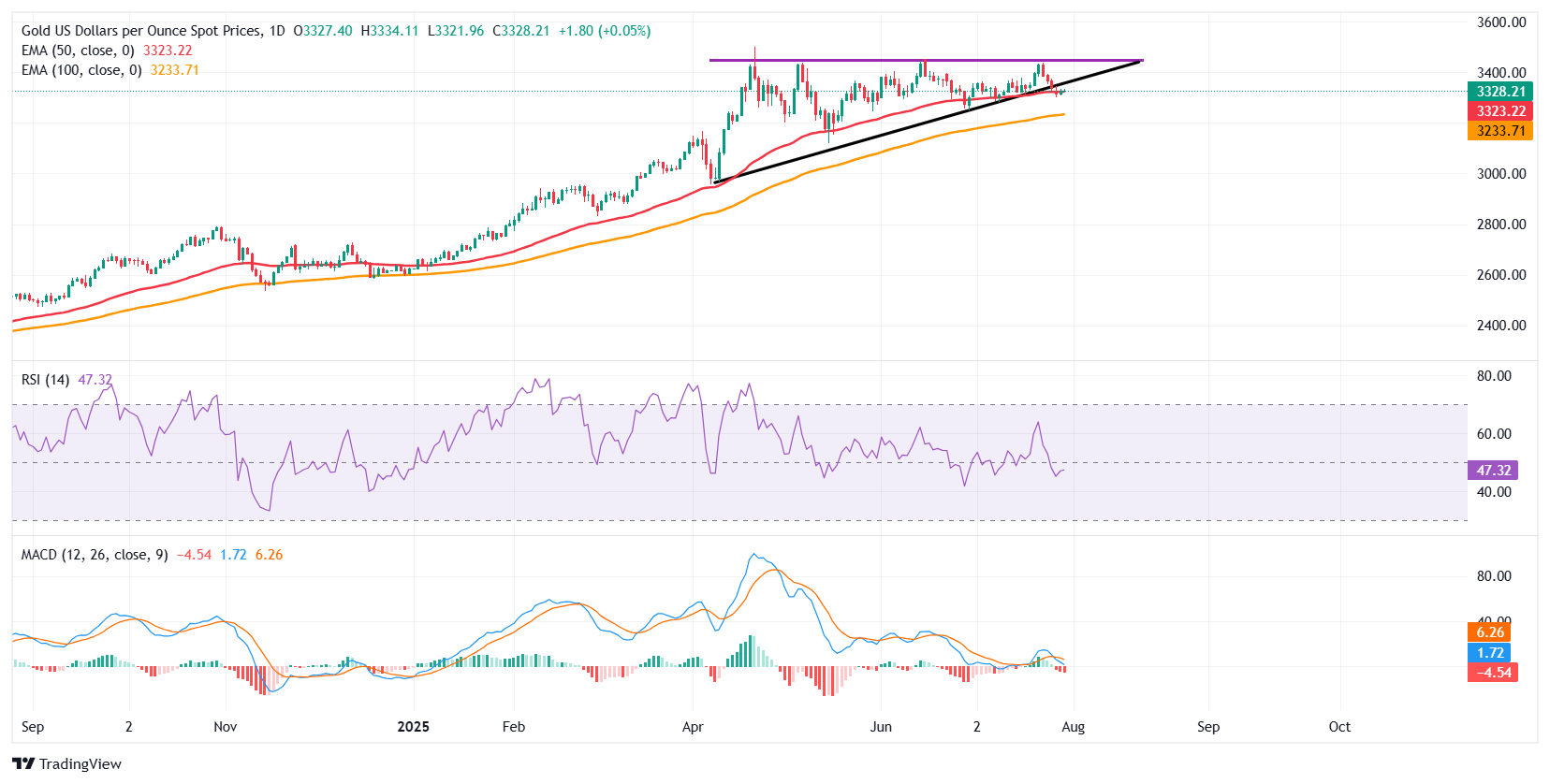- Gold price remains range-bound between $3,300 and $3,330 as traders stay cautious ahead of key US macro data.
- The Federal Reserve is widely expected to keep interest rates steady, but forward guidance on rate cuts is the main market driver.
- Safe-haven demand remains muted amid easing global trade tensions and improving risk appetite.
Gold (XAU/USD) is treading water on Wednesday, hovering near $3,330 during the European trading session. The precious metal is attempting to stabilize after falling to a three-week low of $3,301.90 on Monday. Although price action remains subdued, Gold is oscillating in a narrow range between $3,300 and $3,330.
Easing trade tensions have dampened Gold’s safe-haven appeal, keeping gains in check. However, a softer US Dollar (USD) and a modest pullback in Treasury yields are offering some support. Still, overall risk-on sentiment in the markets is limiting upside momentum as traders brace for the Federal Reserve’s (Fed) monetary policy decision, due Wednesday at 18:00 GMT.
Gold came under pressure last week as improving risk appetite, driven by a series of trade deals, reduced demand for safe-haven assets. The recently announced US-EU deal, which imposes a 15% flat tariff on a wide array of European imports, has added to market optimism that global trade tensions may be cooling. Earlier, the United States (US) also reached a preliminary deal with Japan. Adding to the cautious optimism, negotiations are underway with Canada, South Korea and other trading partners, with hopes high that several more deals could be finalized before the August 1 deadline on Friday.
Meanwhile, US-China trade talks concluded in Stockholm on Tuesday with both sides pledging to maintain open communication and uphold the current tariff truce, set to expire on August 12. While no formal extension was agreed upon, negotiators described the tone as constructive. US President Donald Trump is expected to make the final call on whether to extend the truce, keeping markets in wait-and-watch mode.
Looking ahead, a packed US economic calendar is in focus on Wednesday. The day begins with the ADP Employment Change report for July providing an early look at the health of the labor market ahead of the Non-Farm Payrolls (NFP) report later this week. That’s followed by preliminary readings of Core Personal Consumption Expenditures (PCE) and Q2 Gross Domestic Product (GDP), both of which will help shape expectations around inflation and growth. However, the main spotlight falls on the Fed’s monetary policy decision, followed by Fed Chair Jerome Powell’s press conference, where investors will be looking for clues on the future path of interest rates.
Market movers: Eyes on Fed, GDP, and jobs data
- The yield on the 10-year US Treasury note is holding near 4.33% on Wednesday, stabilizing after a sharp decline in the previous session. Meanwhile, the 30-year yield (US30Y) is trading around 4.86% as investors adopted a cautious stance ahead of the Federal Reserve’s policy announcement.
- The ADP Employment Change report for July, released at 12:15 GMT, showed the U.S. private sector added 104,000 jobs, surpassing expectations of a 78,000 increase and rebounding sharply from June’s revised 33,000 decline.
- The advance reading of Q2 GDP is due at 12:30 GMT, with expectations pointing to a 2.4% annualized expansion, a notable rebound from the -0.5% contraction seen in the previous quarter.
- The core PCE Price Index, the Fed’s preferred inflation metric, is projected to slow to 2.4% QoQ in Q2, down from 3.5% previously.
- The Fed is expected to keep interest rates unchanged at 4.25%-4.50%. However, the real focus will be on the forward guidance as markets are increasingly pricing in a rate cut by September, with odds rising to around 65%, according to CME FedWatch. A dovish Fed tone could weigh on the US Dollar and real yields, offering a fresh upside push to XAU/USD. Conversely, if the Fed pushes back against market pricing or signals that rate cuts aren’t imminent, Gold could struggle to break above its recent range and may dip lower.
- Tuesday’s data offered mixed signals on the US economy. The JOLTS Job Openings report showed vacancies declined by 275,000 to 7.437 million in June, signaling a gradual cooling in labor demand. However, the Conference Board’s Consumer Confidence Index rose to 97.2 in July, up from 95.2 in June and well above expectations of 95.4.
Technical analysis: XAU/USD tests key support near 50-day EMA ahead of Fed

From a technical perspective, XAU/USD is testing a key confluence zone on the daily chart, where the 50-day Exponential Moving Average (EMA) at $3,323.22 overlaps with a rising trendline support drawn from March lows. While the price is currently trading marginally below the ascending trendline, the breach lacks strong momentum, suggesting it may be a false breakout.
The metal remains in a broader uptrend, but short-term momentum has weakened, suggesting indecision as traders await the next catalyst. That catalyst will likely be the Fed’s monetary policy decision on Wednesday. A clear breakout above $3,350 could trigger a bullish continuation, while a breakdown below the 50-EMA might expose the 100-day EMA near $3,233.71.
Momentum indicators tilt bearish but lack conviction. The Relative Strength Index (RSI) has slipped below the neutral 50 mark, currently at 47, indicating weakening bullish momentum with further room to enter oversold territory. The MACD also remains in negative territory, with the signal line crossing above the MACD line and the histogram printing small red bars, pointing to mild downside pressure.
Economic Indicator
Gross Domestic Product Annualized
The real Gross Domestic Product (GDP) Annualized, released quarterly by the US Bureau of Economic Analysis, measures the value of the final goods and services produced in the United States in a given period of time. Changes in GDP are the most popular indicator of the nation’s overall economic health. The data is expressed at an annualized rate, which means that the rate has been adjusted to reflect the amount GDP would have changed over a year’s time, had it continued to grow at that specific rate. Generally speaking, a high reading is seen as bullish for the US Dollar (USD), while a low reading is seen as bearish.
Read more.

